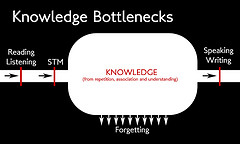|
|
|
Archive for the 'Innovation' Category
Tuesday, May 12th, 2009
Last week I described way to use an innovation wiki to juice creativity and garner ideas from all parts of the company. In the comments Jennifer Brown said, “…[is a] platform across the entire enterprise wherein the innovation “conversation” occurs – not just team by team/vertical by vertical, but across verticals that typically don’t talk to each other (hence leading to silos) or collaborate. …harness the power of the workforce, break the silo’d thinking of functional structures, and revolutionize business models.”
 I agree, but done with a small innovative twist an innovation wiki will break down not only departmental silos, but also the insidious horizontal silos that are based on position and education. I agree, but done with a small innovative twist an innovation wiki will break down not only departmental silos, but also the insidious horizontal silos that are based on position and education.
Personally, I loathe horizontal silos and consider them second only to politics on the corporate stupidity index.
More times than I can count I’ve seen the ideas of an engineer 1 or 2 discounted or ignored by the 3s and senior engineers—of course, that’s better than stealing them, although that happens, too.
The attitude seems to be one of ‘your brain is incapable of any creative thinking until you are at least at my pay grade’, which is idiotic.
People’s brains work differently; some see what is, others see possible improvements and a few see around corners, but that sight has little to do with position. Steve Jobs saw around the corner of the personal computer market before there was a personal computer market and certainly before he had any credibility what so ever.
Nor is it always about training and education. 20 odd years ago I redesigned two street intersection where I lived in San Francisco, but I didn’t suggest the solutions to the traffic engineers—I knew they wouldn’t listen because I have no training. Instead, I sneaked both ideas in through someone I know who was ‘accepted’ and both are still in effect today.
Silos are built of egos, which is why, vertical or horizontal, they’re so difficult to break down.
The best solution is for the CEO to build a culture that values everybody’s ideas equally, but technology offers a leg up on this.
When building your innovation wiki assign a random ID to each suggestion—sort of like match.com. They must be completely random so that level, grade and even department are totally obscured. Each idea has a different ID, so that when a person’s idea is used the next one is still anonymous; limit access of the actual name to a few top executives.
That anonymity truly levels the playing field and means that each idea is considered strictly on its merits, not on the merits of the person who thought of it. It also encourages people to way outside-the-box thinking and to post ideas without worrying about appearing silly, pushy or arrogant for offering ideas outside of their personal expertise.
Just be sure that the contributors of ideas that are used, whether all, in part or as a springboard to something else, receive plenty of public acknowledgement, kudos and anything else you’re in a position to do.
Your comments—priceless
Don’t miss a post, subscribe via RSS or EMAIL
Image credit: ZedBee|Zoë Power on flickr
Posted in Conflict, Ducks In A Row, Innovation | 6 Comments »
Tuesday, May 5th, 2009
Innovation drives the sacred P’s—productivity and profit.
For the smartest companies in this economy innovation didn’t stop with the economic crash; it’s still a hot topic and not just for products and business processes, but through every nook and cranny across the organization.
 Innovation isn’t always earth-shaking or about the next big thing, but large or small, the outcome is always focused on better. Many companies spend big bucks on innovation assistance, hiring top consultants, going on special retreats, etc. Innovation isn’t always earth-shaking or about the next big thing, but large or small, the outcome is always focused on better. Many companies spend big bucks on innovation assistance, hiring top consultants, going on special retreats, etc.
Aside from the fact that spending is more difficult these days, consultants and retreats typically tap only the higher levels of the company ignoring one of the best sources of innovation you have—your own people, all of them.
Assuming you’d like to turn on this innovation faucet, what do you do?
Set up an innovation wiki. Just be sure that the CEO (or top person in the department, group, whatever) support the effort or it’s unlikely to go anywhere.
You want to involve all your people because at all levels they’re the ones who are constantly dealing with your products, processes and customers; who know them intimately and frequently have innovative ideas or are in a position to ask creativity-provoking questions that are just as valuable. What they usually don’t have is a way to get their ideas noticed.
Here’s what to do.
- Create an innovation wiki either on your intranet or at a free host (there are dozens).
- Write a brief description of the wiki’s purpose: That you want to create a “field of dreams and innovation” for all your people to play in to take the organization to the next level.
- Add some basic ground rules tailored to your own organization:
-
- All ideas are welcome, no matter how outrageous or revolutionary they seem.
- No idea is too small; no subject too minor.
- Good ideas have nothing to do with position in the company hierarchy.
- Recruit “early adopters,” those people who love to be on the bleeding edge of what ever is going on. Then create a major internal PR effort encouraging everybody’s participation. Keep the topic high in the company’s consciousness with constant references.
Finally, the most important ingredient to making your innovation wiki a success is to use the ideas!
If you don’t use them people will know it’s a scam and quickly lose interest.
Whether you use them directly or as the springboard to something else, it’s crucial to publicly credit them to the originator.
If you’re in a position to add some kind of incentive or award for each one used (even if the use is indirect) that’s great, but it’s most important to offer major, public appreciation.
Do all this, and they will come.
Your comments—priceless
Don’t miss a post, subscribe via RSS or EMAIL
Image credit: ZedBee|Zoë Power on flickr
Posted in About Leadership, Culture, Entrepreneurship, Innovation, management | 12 Comments »
Monday, April 27th, 2009
As a boss (whether CEO, team leader or any level in-between) you need to accomplish many things within your organization (whether company or team) to be successful, especially in the current economic situation.
Near the top of the list is the need to
- motivate your people (without breaking the bank);
- strengthen and diversify your workforce (often without adding headcount); and
- innovate (products and processes; internally and externally; large and small)
Big order, but here’s how to make it happen.
Start by looking inwards to be sure your MAP supports the program.
 Next, keep this mantra playing in your head Next, keep this mantra playing in your head
- Read it.
- Hear it.
- Do it.
- Teach it.
Then implement it by
- building a useful library, both hard copy (used books are very inexpensive) and online, that includes classic and current information and runs the gamut from traditional to controversial to off-the-wall. Encourage your people to read up on subjects that interest them, whether or not it directly applies to their expertise;
- choosing “topics of the month” based on both need and interest, then encourage free-wheeling discussions on a regular basis;
- modify assignments as much as possible, so people can start to use, and become proficient in, the new skills about which they are reading, learning and talking; and
- supporting brown-bag classes (buy lunch if possible) in which they may teach both their new and original skills to others. Add cross-working assignments to ensure cross-training.
Remember, it’s a long-term fix, because there are no short-term fixes and the only thing you have that’s even close to a silver bullet is your MAP!
Your comments—priceless
Don’t miss a post, subscribe via RSS or EMAIL
Image credit: Felipe Venâncio on flickr
Posted in About Leadership, Culture, Group Dynamics, Innovation, Leadership Skills, management, What Leaders DO | 7 Comments »
Friday, April 17th, 2009
 Shortly after I started writing Leadership Turn I did a post about diversity, ending with this— Shortly after I started writing Leadership Turn I did a post about diversity, ending with this—
“Another way to look at it is that any increased spending on diversity development is an investment and will be more than offset by the increases in innovation, productivity and revenues. If spending $100 results in a bottom line increase of $1000, did you really spend the $100, or did you gain $900? $900 that wouldn’t be there if you hadn’t invested the initial $100.”
How do you define diversity?
True diversity isn’t just diversity of race, gender, creed and country, but what I call the new diversity—all those plus diversity of thought.
Think about it, if a manager really works at it she can create a rainbow-colored group who all think the same way—George W. Bush’s initial Cabinet was ethnically diverse, but their MAP (mindset, attitude, philosophy™) was homogeneous.
It’s far more difficult to put together a group of totally diverse thinkers. Managers tend to hire in their comfort zone, but more and more that refers to how people think, rather than how they look.
So what should you do to ensure that you’re building a truly diversified team?
Here are five key points to keep in mind when you’re both hiring people and managing/leading them.
- Avoid assumptions. People aren’t better because they graduated from your (or your people’s) alma mater, come from your hometown/state or worked for a hot company.
- Know your visual prejudices. Everybody has them (one of mine is dirty-looking, stringy hair), because you can’t hear past them if you’re not aware of them.
- Listen. Not to what the words mean to you, but what the words mean to the person speaking.
- Be open to the radical. Don’t shut down because an idea is off the wall at even the third look and never dismiss the whole if some part can be used.
- Be open to alternative paths. If your people achieve what they should it doesn’t matter that they did it in a way that never would have crossed your mind.
Finally, remember that if you’re totally comfortable, with nary a twinge to ripple your mental lake, your group is probably lacking in diversity.
How do you hire and manage diversity?
Your comments—priceless
Don’t miss a post, subscribe via RSS or EMAIL
Image credit: lumaxart on flickr
Posted in About Leadership, Communication, Culture, Group Dynamics, Innovation, Leadership Choice, Leadership Skills, management, Personal Development, What Leaders DO | 4 Comments »
Monday, April 13th, 2009
 It doesn’t seem that the financial crisis is really changing things all that much. It doesn’t seem that the financial crisis is really changing things all that much.
The exodus of Wall Street bankers is mostly smoke and mirrors, not change, as many of the so-called disgraced leave for banks that didn’t accept bailout money, taking their clients and attitudes with them.
“Banks paid out some $18 billion in bonuses last year, down 44 percent compared with a year earlier, and many workers viewed them as paltry payouts… Sensing a shifting tide, talented bankers who fear a dimmer future at banks that have taken taxpayer money are migrating to brash boutique firms like Aladdin, which are intent on proving their critics wrong by chasing fast profits and growth in hopes of one day rising up as challengers to the old guard.”
Wall Street forces companies to focus on short-term profits, often at the expense of long-term corporate success and innovation, primarily to add more zeros to their own paychecks.
State politicians solve their budget shortfalls by trashing those least likely to vote and completely incapable of donating to their campaigns—the poor, elderly and children.
According to Arizona’s Linda J. Blessing “There’s no question that we’re getting short-term savings that will result in greater long-term human and financial costs,” expressing the concerns of officials and community agencies around the country. “There are no good options, just less bad options.” Ohio’s proposed budget “will dramatically decrease our ability to investigate reports of abuse and neglect,” with some counties losing 75 percent of their investigators The Illinois governor’s budget proposal would scale back home visits to ill-equipped first-time mothers, who are given advice over 18 months that experts say is repaid many times over in reduced child abuse and better school preparation.”
Politicians implement short-term fixes at the cost of long-term social solutions, because (a) they have little negative impact on their re-election and (b) they won’t be around to deal with the mess anyway.
I have an acquaintance who isn’t wealthy, probably midway between middle and upper-middle class. She constantly talks about how she and her husband do everything they can to avoid taxes and would never vote in favor of them no matter what.
During the same conversations she gripes that the unincorporated county where she lives doesn’t plow the road near her house quickly enough when it snows; the ambulance didn’t arrive fast enough when her husband had trouble breathing; her grandchildren’s schools keep reducing enrichment programs and the classes are too large.
Their attitudes aren’t all that unusual.
Does anyone else see a dichotomy here?
Your comments—priceless
Don’t miss a post, subscribe via RSS or EMAIL
Image credit: flickr
Posted in About Leadership, Ethics, Innovation, Leading Stupidities, Politics | 1 Comment »
Saturday, April 11th, 2009
 I’ve always thought of life as a corridor with dozens of doors opening, each one representing an opportunity. I’ve always thought of life as a corridor with dozens of doors opening, each one representing an opportunity.
You may open one or pass them by—it’s your choice.
Each time you do open one and enter that door closes forever and you move down a new corridor full of doors.
The door you entered is sealed because whatever lay behind it changed you, so you can’t go backwards, only forward.
Some people to through life opening as few doors as possible, changing as little as possible and staying as safe as possible.
Others launch themselves through the most interesting doors with gusto, taking advantage of whatever opportunities are concealed and then on to the next door.
In honor of all those who are, or lean to, the latter description I dedicate these two Rules. They are especially apropos today.
Watch for big problems—they disguise big opportunities.
Welcome the unexpected! Opportunities rarely come in neat, predictable packages.
You can’t open every door and you don’t have to stay long if you don’t like what you find, but if you pass straight through never opening any doors you’ll stay in pristine condition and you don’t really want to arrive at the end as untouched as you were when you started—do you?
Your comments—priceless
Don’t miss a post, subscribe via RSS or EMAIL
Image credit: flickr and sxc.hu
Posted in About Leadership, Entrepreneurship, Innovation, Personal Development, Seize Your Leadership Day, What Leaders DO | 2 Comments »
Tuesday, April 7th, 2009
 The world is full of acronyms and many are part of corporate culture, but all acronyms are not created equal. The world is full of acronyms and many are part of corporate culture, but all acronyms are not created equal.
Many are benign, as in executive titles,
- CEO – Chief Executive Officer, COO – Chief Operating Officer, CFO – Chief Financial Officer, CTO – Chief Technology Officer;
or defining the legal entity,
- DBA – Doing Business As, LLC – Limited Liability Company, LLP – Limited Liability Partnership;
or general business terms,
- COB – Close Of Business, COGS – Cost of Goods Sold, PL – Profit and Loss, PO – Purchase Order, QA – Quality Assurance, QC – Quality Control;
or oriented to customers,
- CRM – Client Relationship Management, CSR – Customer Service Rep.
And, of course, the hundreds that are used in the technology world.
Common acronyms or those used within a particular industry are relatively harmless, as long as they’re used sensibly and not to confuse—people who overuse acronyms are PIBs (pain in butt).
There are acronyms that identify dysfunctional people, the ones that aren’t pulling their weight because they’re using,
- OPT – Other People’s Time, OPR – Other People’s Resources, OPM – Other People’s Money.
Then there are the ones that identify actions and MAP that spell big trouble for any culture and need to be eradicated immediately.
- NIMBY – Not In My Back Yard
- NIH – Not Invented Here
- WAM – What About Me
- WIIFM – What’s In It For Me
NIMBY thinking can stifle innovation when it causes discomfort to an individual, group or even division under the corporate umbrella.
NIH also stifles innovation by blinding people to events and new products produced by the competition or other changes in the marketplace.
WAM is different than WIIFM. WAM is usually in response to something good happening to another person; it may be as minor as a compliment from the boss or as substantial as a raise or promotion, whereas WIIFM is the desire to know what personal benefits accrue in return for doing what’s asked. WIIFM isn’t always bad; it can be put to good use by channeling it into positive VSI.
What about your workplace? What acronyms do you hear? Which do you use?
Your comments—priceless
Don’t miss a post, subscribe via RSS or EMAIL
Image credit: flickr
Posted in About Leadership, Communication, Culture, Ducks In A Row, Group Dynamics, Innovation | No Comments »
Monday, March 30th, 2009
 One of the hardest things that growing companies face is the need to stop shooting from the hip. One of the hardest things that growing companies face is the need to stop shooting from the hip.
I hear the reasons not to all the time, from startups, small biz, entrepreneurs, et al:
- It will ruin our culture.
- It stifles creativity. It’s for larger companies.
- It’s bureaucratic. It’s too time consuming.
“It” refers to the underpinnings of all successful companies. “It” includes the following in order of importance:
- Financial controls that include
- monthly statements of revenues by product;
- discounts;
- costs by department;
- cost of goods sold;
- inventory;
- receivables aging;
- stock issuance;
- cash flow;
- manufacturing yields;
- hiring by department
- Annual operating plan covering the above financial measures
- Organization charts and definitions of responsibilities
- Hiring process
- Long-term planning
- Centralized information technology implementation and planning
Whether it’s just you, or one, ten, fifty, or more employees, whether full time, part time or virtual, you need viable processes to keep you focused—think of it as coloring inside the lines.
Everything on this list can, and should, be scaled for applicability, but all are important to every business endeavor.
Those that don’t directly apply may be tweaked, e.g., manufacturing yields can change to productivity measures; a very few, such as “stock issuance” may be completely discarded if the action is truly warranted.
Sure, they can’t all be implemented at once, but none of them will happen as long as your MAP rejects or begrudges them—after all, you’re the boss (CEO/president/managing partner/owner) and people will follow your lead.
Finally, don’t confuse process with bureaucracy. Process is like MAP, it gets you where you want to go, whereas bureaucracy stifles whatever it touches; process, like MAP, is ever-growing, while bureaucracy is carved in stone.
Your comments—priceless
Don’t miss a post, subscribe via RSS or EMAIL
Image credit: flickr
Posted in About Leadership, Culture, Entrepreneurship, Innovation, Leadership Resources, Leadership Skills, management, What Leaders DO | 3 Comments »
Friday, March 20th, 2009
 The markets are in turmoil, the economy sucks, borrowing has gone the way of the dodo bird and businesses large, small and micro are looking to cut costs while still motivating their people. The markets are in turmoil, the economy sucks, borrowing has gone the way of the dodo bird and businesses large, small and micro are looking to cut costs while still motivating their people.
For many companies this means a change in corporate culture, but which changes will have the most impact?
Short answer: creating/enhancing a culture of fiscal intelligence.
Long answer: a transparent culture that spends its money wisely, sharing the reasoning with its people, eliminating low ROI frills and cuts without selling the company’s future down the drain.
This doesn’t mean substituting crappy coffee for the good stuff and eliminating free soda or M&Ms as so many companies do.
It does mean listing all the frills—executive and worker alike—and polling your people to find which are really paying off and which can be scrapped—not a decision made by management, but one that your people hash out and agree to before it’s a done deal.
Sometimes good coffee and soda have a higher ROI morale-wise than you would think.
All this should be doubly true for startups, but it often isn’t. Yes, your money is banked and if you’re VC funded, as opposed to angel, chances are you’re pretty flush—but having it doesn’t mean you should spend it.
Any company that thinks cushy perks are attractive in this economy think again.
Think just how naïve/ignorant/arrogant a candidate must be to expect a large sign-on bonus or fancy perks given current economic conditions.
Not to mention how financially stupid any company still offering them appears to a candidate.
The smartest companies build fiscally intelligent corporate cultures from the beginning, so that when they have to tighten down they know exactly where to cut and their people aren’t surprised.
Throwing money around is always stupid, whether in business or personally.
I’ve heard from companies of all sizes and managers at all levels why this one candidate was worth X more than anyone else walking and how not getting her could deal a crippling, or even lethal, blow to the company.
If you ever feel that way, remember two inimitable truths.
- If not having that one specific person could bring down the company it’s probably going to crash and burn anyway.
- The candidate who joins you for money will always leave for more money.
Remember, the goal is a lean, mean, innovative, motivated machine—not a lean, mean, depressed one.
Your comments—priceless
Don’t miss a post, subscribe via RSS or EMAIL
Image credit: flickr
Posted in About Leadership, Culture, Entrepreneurship, Innovation, Leadership Choice, Leadership Skills, management, What Leaders DO | No Comments »
Sunday, March 15th, 2009
 One way or another I seem to be on a creativity/innovation kick this week, so it seemed reasonable to make that the subject of today’s quotes. One way or another I seem to be on a creativity/innovation kick this week, so it seemed reasonable to make that the subject of today’s quotes.
First the practical…
Innovation comes from the producer – not from the customer. –W. Edwards Deming (You can’t want what you’ve never had.)
Innovation is the whim of an elite before it becomes a need of the public. –Ludwig von Mises (Got to love those early adopters!)
Now the inspirational…
There are no dreams too large, no innovation unimaginable and no frontiers beyond our reach. –John S. Herrington (But you have to believe…)
If you open up the mind, the opportunity to address both profits and social conditions are limitless. It’s a process of innovation. –Jerry Greenfield (But addressing the former with no consideration of the latter is a recipe for disaster.)
Learning and innovation go hand in hand. The arrogance of success is to think that what you did yesterday will be sufficient for tomorrow. –William Pollard (Something that GM and Chrysler still haven’t learned.)
Your comments—priceless
Don’t miss a post, subscribe via RSS or EMAIL
Image credit: flickr
Posted in Culture, Innovation, Leadership Quotes, Quotable Quotes, What Leaders DO | 7 Comments »
|
 Subscribe to
Subscribe to
MAPping Company Success
About Miki 
Clarify your exec summary, website, etc.
Have a quick question or just want to chat? Feel free to write or call me at 360.335.8054
The 12 Ingredients of a Fillable Req
CheatSheet for InterviewERS
CheatSheet for InterviewEEs™
Give your mind a rest. Here are 4 quick ways to get rid of kinks, break a logjam or juice your creativity!
Creative mousing
Bubblewrap!
Animal innovation
Brain teaser
The latest disaster is here at home; donate to the East Coast recovery efforts now!
Text REDCROSS to 90999 to make a $10 donation or call 00.733.2767. $10 really really does make a difference and you'll never miss it.
And always donate what you can whenever you can
The following accept cash and in-kind donations: Doctors Without Borders, UNICEF, Red Cross, World Food Program, Save the Children
*/
?>About Miki
About KG
Clarify your exec summary, website, marketing collateral, etc.
Have a question or just want to chat @ no cost? Feel free to write
Download useful assistance now.
Entrepreneurs face difficulties that are hard for most people to imagine, let alone understand. You can find anonymous help and connections that do understand at 7 cups of tea.
Crises never end.
$10 really does make a difference and you’ll never miss it,
while $10 a month has exponential power.
Always donate what you can whenever you can.
The following accept cash and in-kind donations:
|
 I agree, but done with a small innovative twist an innovation wiki will break down not only departmental silos, but also the insidious horizontal silos that are based on position and education.
I agree, but done with a small innovative twist an innovation wiki will break down not only departmental silos, but also the insidious horizontal silos that are based on position and education.



 Innovation isn’t always earth-shaking or about the next big thing, but large or small, the outcome is always focused on better. Many companies spend big bucks on innovation assistance, hiring top consultants, going on special retreats, etc.
Innovation isn’t always earth-shaking or about the next big thing, but large or small, the outcome is always focused on better. Many companies spend big bucks on innovation assistance, hiring top consultants, going on special retreats, etc. Next, keep this mantra playing in your head
Next, keep this mantra playing in your head Shortly after I started writing Leadership Turn I did a
Shortly after I started writing Leadership Turn I did a  It doesn’t seem that the financial crisis is really changing things all that much.
It doesn’t seem that the financial crisis is really changing things all that much. I’ve always thought of life as a corridor with dozens of doors opening, each one representing an opportunity.
I’ve always thought of life as a corridor with dozens of doors opening, each one representing an opportunity.
 The world is full of acronyms and many are part of corporate culture, but all acronyms are not created equal.
The world is full of acronyms and many are part of corporate culture, but all acronyms are not created equal. One of the hardest things that growing companies face is the need to stop shooting from the hip.
One of the hardest things that growing companies face is the need to stop shooting from the hip. The markets are in turmoil, the economy sucks, borrowing has gone the way of the dodo bird and businesses large, small and micro are looking to cut costs while still motivating their people.
The markets are in turmoil, the economy sucks, borrowing has gone the way of the dodo bird and businesses large, small and micro are looking to cut costs while still motivating their people. One way or another I seem to be on a creativity/innovation kick this week, so it seemed reasonable to make that the subject of today’s quotes.
One way or another I seem to be on a creativity/innovation kick this week, so it seemed reasonable to make that the subject of today’s quotes.
